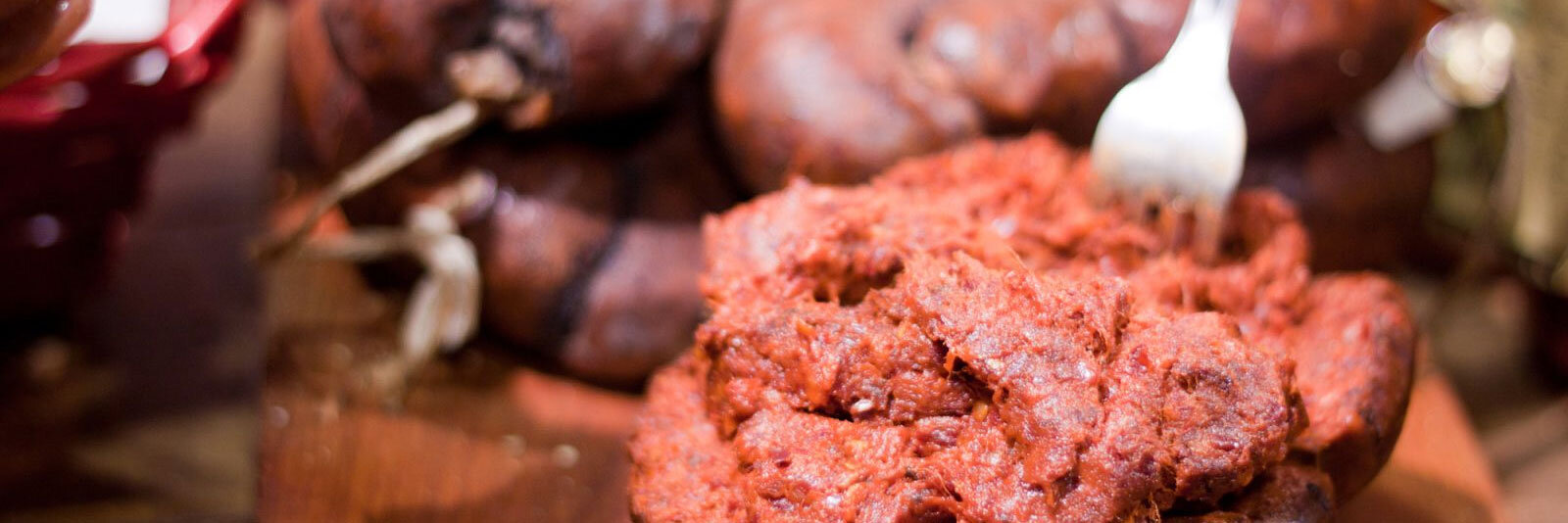A journey inside the typical products made in Calabria
A trip to Southern Italy is inevitably a journey where you go through the smells and flavors of the traditional cuisine.
Plan your food and wine tour in Calabria. Join us and come in a Calabrian kitchen.
Eat authentic, eat natural in Calabria
A way of cooking (organic produce) that has attracted the attention of food scientists.
The Mediterranean Diet, and all the interpretations that nutritionists have built around it, was born in the inland areas between Campania, Basilicata and Calabria.
Using a little courage and a little madness, we tell you that the most radical vegan and a refined gourmand of meat and fish can sit together, passionately, at our table. There is no problem.
Core Calabro will lead you to the origins of food, to know how the raw material is produced.
Extraordinary stories of farmers, breeders, fishermen.
Let’s go and taste the most authentic food and wine.
You have to eat a lot… in Calabria 😋
Eating comes first. “Did you eat?” “What did you eat?” – these are the first two questions, in sequence, your mother asks you on the phone when you travel 📞 .
Calabrian people have an ancestral concern for food.
Probably this behavior denotes a past, not very far away, in which the lack of food was a recurring nightmare and abundance was a true mirage.
In Calabria, even in the 20th century, eating well and plenty was a privilege, it was possible only for the wealthy classes. They have taken the liberty to have a binge, for centuries and centuries. Nobles, powerful people, landowners. There was a time when they could sit at the table and take part in the “cracking” meals, enjoying the first fruits of the season, and the finest meat and fish. The humblest people could only wish.
It is no coincidence – as the anthropologist Vito Teti recalls in several essays – that in some particular days of the year (Christmas holidays or carnival) abundance is celebrated.
In many families there is a more or less conscious, customary celebration of culinary abundance.
They prepare memorable feasts that almost everyone has access to.
It is mostly an exorcism of the scarcity of the past, when frugality was an obligatory choice.
That’s an anthropological fact: during the holidays the heavy social disparities were attenuated, situations of obvious disequilibrium were balanced.
Food culture is a fusion of different ways of cooking, mixing ingredients from different countries
In Calabria food culture is made of many raw materials and thousands of cooking ways. Each territory preserves locally rooted traditions, but still influenced by other cultures.
Think about chili pepper.
Brought by Christopher Columbus from another continent, it has deeply penetrated the local cultures in the modern age and then it has definitively become a main element in the nineteenth century.
Today it is a symbol of Calabrian cuisine.
The Calabrian passion for preserving food
In fact, when discussing food and cooking in Calabria, it is useful to distinguish two moments in the preparation of the dishes to eat.
The most productive phase is naturally linked to preserves. We are talking about that great social party in which family groups (or friends) gather to prepare jars with food preserves.
These are made with care and patience, it’s food that you will find at the table in the long autumn and winter months 🍯 .
We have jams and marmalades of all kinds.
Clementines, bergamot, cherries, peaches, apricots, oranges, strawberries, figs, black cherries, onions …
And then the cedar liqueur, and another with bergamot, licorice, some limoncello. Delicacies.
The laborious meetings to make tomato preserves belong to the production phase – the sauce is a sort of indispensable cult, for thousands of emigrants 🍅 .
The same goes for the preserves of olives, courgettes (zucchini) and eggplants in oil, which are the flavors that make a trip to Calabria worthwhile.
There are also traditions involving meat lovers (pork slaughter, sausages). On the other side, you find the maritime traditions (anchovies preserved in salt, with chilli, or tuna in oil) that create competition between the coastal villages.
Among the mountains and valleys of Pollino, Sila, Aspromonte, as well as between the Serre Vibonesi or in the Crotone Marquisate, you find the dairy craftsmanship champions.
They produce caciocavallo, pecorino and goat cheese, ricotta and mozzarella of excellent quality.
Cooking class for tourists
Alongside with the transformation of the sea and farmland products, there is then the cooking moment, in front of the stove and the pots!
Here mothers, grandmothers, aunts, custodians of age-old knowledge and traditions, start teaching. Listen to their advice and you will cook like God!!
Nobody beats them in the kitchen, whether it’s preparing a typical dessert or delighting guests for lunch with tasty dishes.
The dedication of these women is really moving.
Would you like to participate in a very original food and wine tour in Calabria?
A tour to discover what is typical, in each town of Calabria
Each area (in our map) has a marked identity, a know-how very, very specialized in making some typical products associated with the name Calabria.
Each area may have a specific vocation for the production of certain fruits, vegetables, meats, cheeses, etc.
A spicy star:
la ‘nduja
The secret of the ‘nduja preparation, on the mount Poro plateau rather than in the river Mesima valley (towns like Spilinga), is about the dosage.
If ‘nduja has that unique taste, it is because someone knows the secret of the dosage and the quality of chili pepper to mix with minced bacon and lard.
Anyway, don’t believe Calabria is only ‘nduja and chilli❗
Desserts (lovely) made in Calabria
The topic “typical desserts of Easter and Christmas holidays” would deserve a dedicated volume.
Telling the local variations of a dessert is a beautiful and arduous undertaking, since it is truly a thousand shades of dough and combinations of ingredients that change from one village to another.
Think about the colorful honey biscuits, which have bizarre shapes, called mostaccioli (but also mastazzoli, mustazzoli etc …), which in the traditions of Soriano Calabro reach very high creative peaks, filling Christmas celebrations, patronal feasts and more with sweetness.
Think about the widespread quality of the torroni (nougat) masters, between Bagnara Calabra and Taurianova.
Consider the extraordinary story of the ice cream called Tartufo, in Pizzo Calabro, which is pure joy for the palates of tourists.
PDO and PGI European Union agricultural recognitions
Calabria has a rich history of PDO and PGI recognitions.
In recent decades, Calabrian products have been conquering the salons of taste, the food fairs and the tables all over the world.
Some examples. Core Calabro goes crazy for Caciocavallo Silano – which together with Patata della Sila forms a golden couple in the Calabrian agricultural and pastoral economy.
They are the basis of typical dishes and are never lacking in the menus of the restaurants in Sila National Park.
In every Calabrian appetizer there is a piece of Pecorino Crotonese or the equally exquisite one from mount Poro in the province of Vibo.
Soppressata is something extraordinary. It is a constant presence on the Calabrian tables.
The Calabrian veneration for “His Majesty The Pig” means that the soppressata may taste different, it may have nuances of flavor from place to place.
Tropea Red Onion has already conquered everyone, it is acclaimed by great chefs and even requested by multinationals operating in the food sector.
Clementines 🍊 , grown mainly in the Plain of Sibari, are present in fruit and vegetable markets and supermarkets throughout Italy.
Farmers, producers, chefs, sommeliers: tourists looking for food excellence in Calabria
Core Calabro will sneak into the kitchen to interview chefs and aspiring chefs skilled at enhancing the best of Calabria.
We will see how tradition is mixing with ideas from other cultures.
In our documentaries we will propose – they are fundamental steps to approach regional gastronomy – it will be understood how many typical dishes were recently invented.
They were conceived between 1800 and 1900, so they are not a millennial legacy dating back to the Greek colonies.
This is the age of food mania.
We are overwhelmed by TV programs, YouTube channels, paper inserts and blogs focused on cooking and chef shows (there are some of them very skilled, which we will not fail to mention).
Our ambition is to give the audience a substantial guide to the history of products and producers.
The tourist who tastes food and drinks local wines, well, he needs to know and imagine, before chewing or sipping.
By the way, wine. We haven’t forgotten it. We have great wine producers. Farmers who feed their vines adding a moving affection. They excite us.
It is a love blossomed centuries ago, wonderfully aged. 🍇 A miracle of patience, technique and passion.

